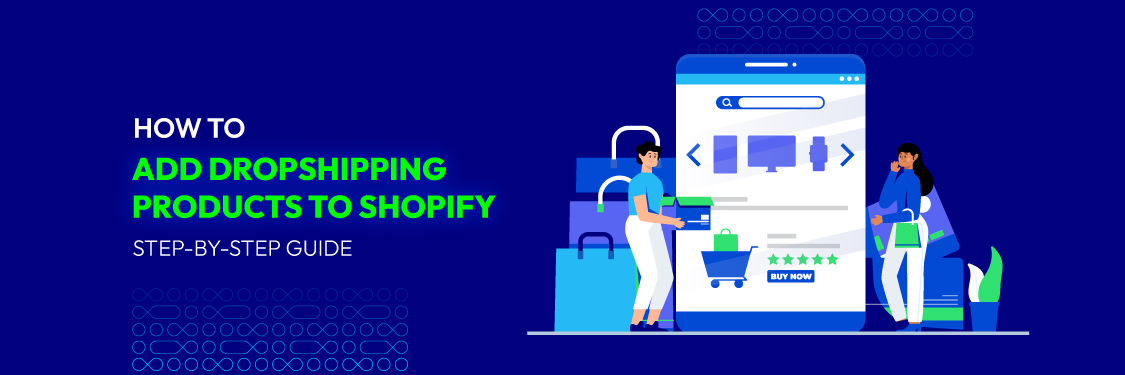How to Add Dropshipping Products to Shopify: Step-by-Step Guide
Summer Nguyen | 01-16-2024

The global dropshipping market is booming, projected to reach a staggering 476.1 billion U.S. dollars by 2026. Are you ready to tap into this lucrative opportunity? Shopify provides a powerful platform for building your own dropshipping empire, and adding products to your store is the first step.
In this comprehensive guide, we’ll walk you through the step-by-step process of how to add dropshipping products to Shopify and share some pro tips for successful dropshipping on Shopify. Whether you’re a seasoned entrepreneur or just starting, this guide will equip you with the knowledge and tools you need to create a thriving online business.
Learn About Shopify Dropshipping
Shopify dropshipping is a business model where you sell products online without holding any inventory. With Shopify, you can easily create your online store and partner with suppliers who handle storage and shipping. This means no upfront inventory costs or physical product handling, allowing you to focus on marketing and sales. However, dropshipping can be competitive, so choosing the right products and marketing effectively are crucial for success.

Here’s how the Shopify dropshipping model typically works:
- Create Your Shopify Store: Design and customize your online shop.
- Install a Dropshipping App: Connect with suppliers and import products.
- Select Products To Sell: Choose from a wide range of items to sell on your online store.
- Optimize Listings: Enhance product descriptions and images for better visibility.
- Customer Orders: Orders are automatically sent to your dropshipping app.
- Supplier Fulfills Order: The supplier ships directly to the customer.
- Customer Receives Product: Package arrives with your store’s branding.
- You Handle Customer Service: Manage inquiries and returns.
Learn more: Shopify Dropshipping for Beginners: 15 Important Steps to Start
Free 1-1 Consultation: Shopify Store Setup
- Ensure store readiness for driving traffic
- 100% satisfaction or money-back guarantee
- 30 support days
- 45 days of expert guidance/personalized support
- 45 days of unlimited revisions
- 3-month free trial of 12 Avada apps
How to Add Dropshipping Products to Shopify?
Adding dropshipping products to your Shopify store involves several steps. Here’s a step-by-step guide on how to do it:
Method 1: Manual Product Import
This method involves manually copying and pasting product details from your dropshipping supplier’s website into your Shopify store. Although it is more time-consuming, it offers greater control over product presentation. This approach is ideal for managing a small number of products or if you prefer a hands-on method.
Follow the steps below:
Step 1: Gather Product Details
After selecting products from your supplier’s website that you want to add to your store, carefully copy all relevant product information, including:
- Title: The product name.
- Description: A detailed description of the product’s features and benefits.
- Images: High-quality product images from different angles. Save these images to your computer.
- Pricing: The supplier’s wholesale price (your cost) and your retail price (what you’ll charge customers).
- Variants: If the product comes in different sizes, colors, etc., note the details of each variant.
Step 2: Enter Product Details in Shopify
In your Shopify admin, go to “Products” > “Add product.”. Then paste the copied information into the corresponding fields in Shopify:
- Title (in the “Title” field)
- Description (in the “Description” field)
- Upload images (click “Add new” under “Media”)
- Set pricing (in the “Pricing” section)
- Create variants (if applicable, in the “Variants” section)
- Fill in other relevant details like product type, vendor, tags, etc. if it’s necessary.


Step 3: Save and Publish
Once everything looks correct, click “Save” to complete the operation. Don’t forget to choose “Active” (in the “Status” field) to publish the product in your store.
Method 2: Use Product Importers
Step 1: Source Product Data
Obtain a CSV file containing product information from your dropshipping supplier. Many suppliers offer this option. If not, you might need to create your own CSV using product details from their website.

Step 2: Choose an Importer
Select a product importer app or service that is compatible with Shopify. Some popular options include:
- Shopify’s built-in importer: This is a basic option included with your Shopify plan, but it might have limitations for larger imports.
- Third-party apps: Apps like EZ Importer, Excelify or Matrixify offer more advanced features and better support for large-scale imports.
Step 3: Map Fields
Most importers will require you to map the columns in your CSV file to the corresponding fields in Shopify (e.g., “Title” in your CSV matches the “Product Title” field in Shopify).
Step 4: Upload and Import
Upload your CSV file to the importer, review the field mapping, and start the import process. The importer will create or update products in your Shopify store based on the data in your file.


Step 5: Review and Publish
After the import, review the newly added products in your Shopify store to ensure everything looks correct. Make any necessary adjustments, then publish the products to make them available to customers.
Method 3: Use Dropshipping Apps
Step 1: Install a Dropshipping App
This is the most popular method to add dropshipping products to Shopify because of its effectiveness. There are several Shopify apps for dropshipping. One of the popular apps is DSers. Here’s how to install it:
- Access the Shopify app store: From your Shopify dashboard, go to “Apps” and click “Visit Shopify App Store.”
- Search for DSers: In the App Store, search for “DSers” or your preferred dropshipping app.

- Install the app: Click the “Install” button next to the app you want to use. Observe the instructions provided on the screen to finalize the installation.

Step 2: Connect Your Store to the Dropshipping App
Now that you have the dropshipping app installed, you’ll need to connect it to your Shopify store. Here’s how to do it using DSers as an example:
- Access the app: Go to your Shopify dashboard and click on the dropshipping app you installed (e.g., DSers)
- Create an account: If you’re using DSers, you’ll need to create a DSers account or log in with your existing credentials.

- Link to your Shopify store: Follow the prompts to link DSers to your Shopify store. This integration allows you to manage products seamlessly.

Step 3: Import Products
With your store connected to the dropshipping app, you can now start importing products:
- Browse products: Use the dropshipping app to browse the catalog of products offered by your chosen suppliers. Select the products you want to add to your store.
- Customize product details: Before importing, customize product details such as titles, descriptions, and prices to make them more appealing to your target audience.
- Import products: Once you’ve customized the product details, click the “Import to Store” button. The selected products will be added to your Shopify store.

- Organize your products: After importing, organize your products into collections or categories to enhance navigation for your customers.
Step 4: Organize Your Products
Once you’ve imported dropshipping products into your Shopify store, organizing them effectively is crucial. Organized products make it easier for customers to navigate and find what they want. Here’s what you can do:
- Create collections or categories: Group similar products into collections or categories. For instance, if you sell clothing, you might have collections like “Men’s Apparel,” “Women’s Apparel,” and “Accessories.” Shopify allows you to create these collections, making browsing simpler for customers.
- Use tags: Apply relevant tags to products. Tags are keywords or labels that help you organize products further. For example, you can tag products with attributes like “New Arrivals,” “On Sale,” or “Best Sellers.”
- Featured products: Highlight featured products on your homepage or category pages to draw attention to specific items or promotions.
Step 5: Set Prices and Descriptions
After organizing your products, it’s essential to set competitive prices and create appealing product descriptions. Here’s how:
- Pricing strategy: Review the prices imported from your suppliers and adjust them as needed. When setting prices, consider your profit margin, competitor pricing, and market demand. Ensure your prices are competitive while still allowing you to make a profit.
- Product descriptions: Customize product descriptions to make them unique and engaging. Write detailed, informative, and persuasive descriptions highlighting each product’s benefits and features. Utilize top-notch images and videos to display products from different angles.
Step 6: Optimize Product Pages
For boosting organic traffic and enhancing your store’s search engine visibility, it’s essential to optimize your product pages with SEO (Search Engine Optimization) techniques. Here’s how:
- Keyword research: Perform keyword research to discover pertinent keywords/phrases related to your products and niche. Employ tools like Google Keyword Planner to uncover high-traffic, low-competition keywords.

- On-page optimization: Incorporate these keywords naturally into your product titles, descriptions, and alt tags for images. Write SEO-friendly meta descriptions and product URLs. Ensure your site loads quickly, as page speed can impact search rankings.
- Mobile optimization: Ensure your store for mobile devices since many online shoppers use smartphones and tablets. Check the mobile responsiveness of your store’s design and layout.
Step 7: Test Your Checkout Process
Before launching your store, it’s crucial to test the entire checkout process to ensure a seamless and hassle-free customer experience. Here’s what to check:
- Place test orders: Create test orders using dummy or personal information to ensure that orders are correctly processed and sent to your dropshipping suppliers.
- Payment gateway: Test different payment methods, such as credit cards, PayPal, or other options you offer. Ensure that payments are processed securely.
- Shipping and taxes: Verify that shipping costs and taxes are calculated accurately based on customer locations and the products ordered.
- Order confirmation: Confirm that customers receive order confirmation emails promptly after purchasing. Ensure the emails contain all necessary information, including order and tracking information (if applicable).
Step 8: Launch Your Store
Once you’ve completed all the necessary preparations, it’s time to officially launch your Shopify store. Here are some steps to consider:
- Announce the launch: Let your audience know that your store is live. Utilize social media, email marketing, and various other promotional channels to create excitement and attract initial traffic.
- Promotions: Consider launching special promotions or discounts to encourage early sales and generate buzz around your store.
Step 9: Monitor and Optimize
After your store is live, the work doesn’t stop. Continuously monitor and optimize your store for better performance:
- Analyze traffic: Use Shopify’s built-in analytics tools and platforms like Google Analytics to monitor visitor behavior, sales metrics, and conversion rates. Analyze this data to make informed decisions.
- Customer feedback: Listen to customer feedback and promptly address any concerns or issues. Positive reviews can boost your store’s reputation.
- A/B testing: Experiment with marketing strategies, product offerings, and website optimizations. Perform A/B tests to identify what delivers optimal results for your specific business.
- Scale and expand: As your store grows, consider expanding your product range, marketing efforts, or even diversifying into new niches.
6 Tips for Successful Dropshipping on Shopify
Achieving success with your dropshipping business on Shopify entails more than just setting up a store and adding products. Here are some tips to help you succeed:
1. Research Your Niche and Target Audience Thoroughly
Successful dropshipping begins with in-depth research. Take the time to thoroughly understand your chosen niche. Investigate market trends, identify product demand, and explore potential competitors.
This research should also extend to understanding your target audience. What are their preferences, needs, and pain points? A comprehensive buyer persona can help guide your product selection and marketing efforts.
The more you know about your niche and audience, the better positioned you’ll be to make informed decisions that drive your business forward.
2. Choose Reliable and Reputable Suppliers
The backbone of any dropshipping venture is the relationship with your suppliers. Partnering with trustworthy and dependable suppliers is paramount.

Look for suppliers who not only offer quality products but also excel in shipping times, order accuracy, and customer service. Conduct thorough due diligence when selecting suppliers by reading reviews, seeking recommendations, and communicating directly with potential partners.
A strong and reliable supplier network is the cornerstone of a successful dropshipping operation.
3. Optimize Your Product Listings
Your product listings are the digital storefront of your Shopify store. To maximize conversions, they should be both appealing and informative.
Utilize high-quality images that showcase your products from various angles. Craft compelling and concise product descriptions highlighting each item’s benefits and features. Ensure that your pricing is competitive and accurate. Incorporate relevant keywords into your listings to enhance your search engine visibility and attract organic traffic.
Well-optimized product listings can significantly improve your chances of attracting and converting potential customers.
4. Implement Effective Marketing Strategies
To drive traffic and sales, a well-rounded marketing strategy is essential. Consider a mix of digital marketing tactics, including:
- Social media marketing: Use platforms like Facebook, Instagram, and Pinterest to reach and engage your target audience.
- Email marketing: Establish and cultivate an email list to share information with customers regarding promotions, new products, and valuable content.
- Content marketing: Create blog posts, videos, and other content that provides value to your audience and establishes your authority within your niche.
- Pay-per-click advertising: Use platforms like Google Ads or Facebook Ads to focus on particular demographics and generate traffic.
- Search engine optimization (SEO): Optimize your website for search engines to improve organic rankings.
Try out various marketing channels and strategies to determine which resonates most effectively with your audience. Consistently assess the effectiveness of your marketing endeavors to refine your approach over time.
5. Provide Excellent Customer Service
Outstanding customer service is a hallmark of successful dropshipping businesses. Timely and courteous responses to customer inquiries and concerns can lead to positive reviews, repeat business, and referrals.
Consider offering a straightforward return and refund policy to instill confidence in your customers. Keep buyers informed about order status and shipping updates. Personalize the shopping experience when possible to make customers feel valued.
By prioritizing customer service, you can build trust and loyalty, essential for long-term success.
6. Continuously Analyze and Adjust Your Business Strategy
The e-commerce landscape is dynamic, with market trends and consumer preferences evolving. It’s crucial to regularly analyze your store’s performance.
Utilize Shopify’s analytics tools and other data sources to monitor crucial metrics like conversion rates, customer acquisition cost, and customer lifetime value. This data will provide insights into what’s working and what isn’t.
Stay ready to adapt your business strategy accordingly, whether refining your product selection, optimizing your marketing campaigns, or improving your website. Flexibility and adaptability are essential qualities for thriving in the ever-changing world of dropshipping.
Conclusion
In conclusion, adding dropshipping products to your Shopify store is an essential journey for anyone looking to establish a thriving e-commerce business. Following the step-by-step guide provided here, you’ve learned the fundamental building blocks required to create a successful online store.
Your Shopify dropshipping store promises to turn your entrepreneurial aspirations into reality. With this guide, you’re well-prepared to embark on your e-commerce journey and create a thriving online business. Best of luck!





